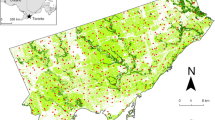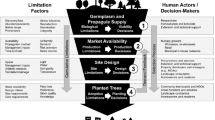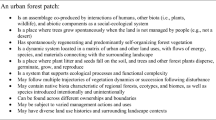Abstract
To many people the term urban forest seems incongruous and contradictory. But a look around any major city quickly reveals that trees and other vegetation are an important feature in many urban settings. For example, an aerial photo survey of Dayton, Ohio, showed that 22% of the city’s land area is covered with trees, and that 35% is covered with other kinds of vegetation (Sanders & Stevens, 1984). According to one overall estimate, 30% of the average city in the United States is covered with trees, a proportion larger than the average tree cover for countryside (Dwyer, Deneke, Grey, & Moeller, 1983).
Access this chapter
Tax calculation will be finalised at checkout
Purchases are for personal use only
Preview
Unable to display preview. Download preview PDF.
Similar content being viewed by others
References
Allen, P. G., Stevens, T. H., & More, T. A. (1985). Measuring the economic value of urban parks: A caution. Leisure Sciences, 7(4), 467–477.
Allton, D. J., & Lieber, S. R. (1983). Attributes of Chicago trail areas. Leisure Sciences, 5(3), 197–220.
Ames, R. G. (1980). Urban tree planting programs: A sociological perspective. HortScience, 25(2), 135–137.
Anderson, L. M., & Cordell, H. K. (1985). Residential property values improved by landscaping with trees. Southern Journal of Applied Forestry, 9(3), 162–166.
Anderson, L. M., & Eaton, T. A. (1986). Liability for damage caused by hazardous trees. Journal of Arboriculture, 12(8), 189–195.
Anderson, L. M., & Schroeder, H. W. (1983). Application of wildland scenic assessment methods to the urban landscape. Landscape Planning, 10, 219–237.
Anderson, L. M., Mulligan, B. E., Goodman, L. S., & Regen, H. Z. (1983). Effects of sounds on preferences for outdoor settings. Environment and Behavior, 15(5), 539–566.
Buhyoff, G. J., Gauthier, L. J., & Wellman, J. D. (1984). Predicting scenic quality for urban forests using vegetation measurements. ForestScience, 30(1), 71–82.
Christensen, H. H., & Clark, R. N. (1983). Increasing public involvement to reduce de-preciative behavior in recreation settings. Leisure Sciences, 5(4), 359–379.
Chubb, M., & Westover, T. N. (1980). Antisocial behavior: Typology, messages, and implications for recreation resource managers. In Proceedings of Land-Use Allocation: Processes, People, Politics, Professionals. Spokane, WA.
Clark, R. N., & Stankey, G. H. (1979). The recreation opportunity spectrum: A framework for planning, management, and research (USDA Forest Service General Technical Report PNW-98). Portland, OR: Pacific Northwest Forest and Range Experiment Station.
Coughlin, R. E., & Strong, A. L. (1983). Forests, fields, and urban development: Planning as though vegetation really mattered (Research Report Series no. 2). Philadelphia: University of Pennsylvania, Department of City and Regional Planning.
Coughlin, R. E., Mendes, D. C., & Strong, A. L. (1984). Private trees and public interest: Programs for protecting and planting trees in metropolitan areas (Research Report Series no. 10). Philadelphia: University of Pennsylvania, Department of City and Regional Planning.
Darragh, A. J., Peterson, G. L., & Dwyer, J. F. (1983). Travel cost models at the urban scale. Journal of Leisure Research, 15(2), 89–94.
Dwyer, J. F. (1980). Managing urban forests for recreation. Trends, 17(4) 11–14.
Dwyer, J. F., & Schroeder, H. W. (1982). Urban river recreation: New challenges and opportunities. Naturalist, 33(Summer), 6–10.
Dwyer, J. F., & Strong, A. L. (1986). Urban-rural forestry in the Netherlands. Journal of Forestry, 84(2), 57–59.
Dwyer, J. F., Deneke, F. J., Grey, G. W., & Moeller, G. H. (1983). Urban forests: Where trees and people go together. In 1983 USDA yearbook of agriculture. Washington, DC: U.S. Department of Agriculture.
Dwyer, J. F., Schroeder, H. W., & Buck, R. L. (1985). Patterns of use in an urban forestrecreation area. In Proceedings of the 1985 National Outdoor Recreation Trends Symposium, Vol. 2. Myrtle Beach, SC.
Fritschen, J. M., & Stynes, D. J. (1980). Interpretation for urban audiences. In Proceedings of the Association of Interpretative Naturalists Workshop. Cape Cod, MA.
Getz, D. A., Karow, A., & Kielbaso, J. J. (1982). Inner city preferences for trees and urban forestry programs. Journal of Arboriculture, 8(10), 258–263.
Godbey, G., & Blazey, M. (1983). Old people in urban parks: An exploratory investigation. Journal of Leisure Research, 15(3), 229–244.
Gold, S. M. (1983a). A human service approach to recreation planning. Journal of Park and Recreation Administration, 1(1), 27–37.
Gold, S. M. (1983b). Risk management in public playgrounds. Journal of Park and Recreation Administration, 1(3), 1–10.
Grey, G. W., & Deneke, F. J. (1986). Urban forestry (2nd ed.). New York: Wiley.
Hagerty, J. K., Stevens, T. H., Allen, P. G., & More, T. (1982). Benefits from urban open space and recreational parks: A case study. Journal of the Northeastern Agricultural Economics Council, 11(1), 13–20.
Hayward, D. G., & Weitzer, W. H. (1983). Understanding urban park users: A key to effective planning and management. Parks and Recreation Resources, 2(2), 24–27.
Hayward, D. G., & Weitzer, W. H. (1984). The public’s image of urban parks: Past amenity, present ambivalence, uncertain future. Urban Ecology, 8, 243–268.
Herzog, T. R., Kaplan, S., & Kaplan, R. (1982). The prediction of preference for unfamiliar urban places. Population and Environment, 5(1), 43–59.
Hutchison, R., & Fidel, K. (1984). Mexican-American recreation activities: A reply to McMillen. Journal of Leisure Research, 16(4), 344–349.
Kaplan, R. (1980). Citizen participation in the design and evaluation of a park. Environment and Behavior, 12(4), 494–507.
Kaplan, R. (1981). Evaluation of an urban vest-pocket park (USDA Forest Service Research Paper NC-195). St. Paul: North Central Forest Experiment Station.
Kaplan, R. (1982). Managing greenspace in multiple-family neighborhoods. In Proceedings of the 1982 Convention of the Society of American Foresters. Cincinnati, OH.
Kaplan, R. (1983). The role of nature in the urban context. In I. Altman & J. F. Wohlwill (Eds.), Behavior and the natural environment. New York: Plenum.
Kaplan, R. (1984a). Dominant and variant values in environmental preference. In A. S. Devlin & S. L. Taylor (Eds.), Environmental preference and landscape preference. New London: Connecticut College.
Kaplan, R. (1984b). Human needs for renewable resources and supportive environments. In G. A. Bradley (Ed.) Land use and forest resources in a changing environment: The urban/forest interface. Seattle: University of Washington Press.
Kaplan, R. (1984c). Impact of urban nature: A theoretical analysis. Urban Ecology, 8, 189–197.
Kaplan, R. (1985). Nature at the doorstep: Residential satisfaction and the nearby environment. Journal of Architectural and Planning Research, 2, 115–127.
Kellert, S. R. (1984). Urban American perceptions of animals and the natural environment. Urban Ecology, 8, 209–228.
Lieber, S. R., & Allton, D. J. (1983). Modeling trail area evaluations in metropolitan Chicago. Journal of Leisure Research, 15(3), 184–202.
Lieber, S. R., & Fesenmaier, D. R. (1985). Physical and social conditions affecting recreation site preferences. Environment and Planning A, 17, 1613–1625.
Lien, J. N., & Buhyoff, G. J. (1986). Extension of visual quality models for urban forests. Journal of Environmental Management, 22(3), 245–254.
Marans, R. W., & Fly, J. M. (1981). Recreation and the quality of urban life (Research Report Series). Ann Arbor: The University of Michigan, Institute for Social Research.
Metro, L. J., Dwyer, J. F., & Dreschler, E. S. (1981). Forest experiences of fifth-grade Chicago public school students (USDA Forest Service Research Paper NC-216). St. Paul: North Central Forest Experiment Station.
Morales, D. J., Micha, F. R., & Weber, R. L. (1983). Two methods of evaluating trees on residential sites. Journal of Arboriculture, 9(1), 21–24.
More, T. A. (1980). Trail deterioration as an indicator of trail use in an urban forest recreation area (USDA Forest Service Research Note NE-292). Broomall, PA: Northeastern Forest Experiment Station.
More, T. A. (1983). The nonusers of an urban forest interpretive center. Journal of Interpretation, 8(1), 1–9.
More, T. A. (1984). A practical guide to the use of observation in the study of urban parks. In J. D. Peine (Ed.), Proceedings of a workshop on unobtrusive techniques to study social behavior in parks. Atlanta: U.S. Department of the Interior, National Park Service.
More, T. A. (1985a). Central city parks: A behavioral perspective. Burlington: University of Vermont, School of Natural Resources.
More, T. A. (1985b). Evaluating and interpreting use data in urban park settings. In Proceedings of the 1985 National Outdoor Recreation Trends Symposium Vol. 2. Myrtle Beach, SC.
Nasar, J. L. (1981). Visual preferences of elderly public housing residents: Residential street scenes. Journal of Environmental Psychology, 1, 303–313.
O’Leary, J. T. (1982). Managing urban river corridors: Implications for urban forestry. In Proceedings of the 1982 Convention of the Society of American Foresters. Cincinnati, OH.
O’Leary, J. T., & Benjamin, P. J. (1982). Ethnic variation in leisure behavior: The Indiana case (Station Bulletin no. 349). West Lafayette, IN: Purdue University, Department of Forestry and Natural resources, Agricultural Experiment Station.
Palmer, J. F. (1984). Neighborhoods as stands in the urban forest. Urban Ecology, 8, 229–241.
Peterson, G. L., Dwyer, J. F., & Darragh, A. J. (1983). A behavioral urban recreation site choice model. Leisure Sciences, 6(1), 61–81.
Peterson, G. L., Stynes, D. J., Rosenthal, D. H., & Dwyer, J. F. (1985). Substitution in recreation choice behavior. In Proceedings of symposium on recreation choice behavior (USDA Forest Service General Technical Report INT-184, pp. 19–30). Ogden, UT: Intermountain Research Station.
Samdahl, D. M., & Christensen, H. H. (1985). Environmental cues and vandalism: An exploratory study of picnic table carving. Environment and Behavior, 17(4), 445–458.
Sanders, R. A. (1981). Diversity in the street trees of Syracuse, New York. Urban Ecology, 5, 33–43.
Sanders, R. A. (1984). Estimating satisfaction levels for a city’s vegetation. Urban Ecology, 8, 269–283.
Sanders, R. A., & Rowntree, R. A. (1984). Environmental management through urban forestry on the hillsides of Cincinnati, Ohio. Journal of Environmental Management, 19, 161–174.
Sanders, R. A., & Stevens, J. C. (1984). Urban forest of Dayton, Ohio: A preliminary assessment. Urban Ecology, 8, 91–98.
Schabel, H. G., & Dwyer, J. F. (1985). Institutional aspects of forest recreation resource management in West Germany. Landscape Journal, 4(1), 1–6.
Schroeder, H. W. (1982). Preferred features of urban parks and forests. Journal of Arboriculture, 8(12), 317–322.
Schroeder, H. W. (1983). Variations in the perception of urban forest recreation sites. Leisure Sciences, 5(3), 221–230.
Schroeder, H. W., & Anderson, L. M. (1984). Perception of personal safety in urban recreation sites. Journal of Leisure Research, 16(2), 178–194.
Schroeder, H. W., & Appelt, P. (1985). Public attitudes toward a municipal forestry program. Journal of Arboriculture, 11(1), 18–21.
Schroeder, H. W., & Cannon, W. N. Jr. (1983). The esthetic contribution of trees to residential streets in Ohio towns. Journal of Arboriculture, 9(9), 237–243.
Schroeder, H. W., & Green, T. L. (1985). Public preference for tree density in municipal parks. Journal of Arboriculture, 11(9) 272–277.
Schroeder, H. W., & Louviere, J. J. (1986). A model for predicting distribution of recreational use over a system of parks. In Proceedings of the Forestry Microcomputer Software Symposium. Morgantown: West Virginia University, Division of Forestry
Shaffer, G. S., & Anderson, L. M. (1985). Perceptions of the security and attractiveness of urban parking lots. Journal of Environmental Psychology, 5, 311–323.
Shaw, W. W., Mangun, W. R., & Lyons, J. R. (1985). Residential enjoyment of wildlife resources by Americans. Leisure Sciences, 7(3), 361–375.
Smardon, R. C. (1985). A visual approach to redesigning the commercial strip highway. Transportation Research Record No. 1016, 1–6.
Spotts, D. M., & Stynes, D. J. (1984). Public awareness and knowledge of urban parks: A case study. Journal of Park and Recreation Administration, 2(4), 1–12.
Spotts, D. M., & Stynes, D. J. (1985). Measuring the public’s familiarity with recreation areas. Journal of Leisure Research, 17(4), 253–265
Stamps, S. M. Jr., & Stamps, M. B. (1985). Race, class, and leisure activities of urban residents. Journal of Leisure Research, 17(1), 40–56.
Stiegler, J. E. (1985). Public perception of the urban forest. Unpublished master’s thesis, University of Minnesota, Graduate School, St. Paul.
Stynes, D. J., Spotts, D. M., & Strunk, J. R. (1985). Relaxing assumptions of perfect information in park visitation models. Professional Geographer, 37(1), 21–28.
Talbot, J. F. (1982). Zoning reconsidered: The impacts of environmental aesthetics in urban neighborhoods. In P. Bart, A. Chen, & G. Francesato (Eds.), Proceedings of EDRA 13: Knowledge for Design. Washington, DC: Environmental Design and Research Association.
Talbot, J. F., & Kaplan, R. (1984). Needs and fears: The response to trees and nature in the inner city. Journal of Arboriculture, 10(8), 222–228.
Talbot, J. F., & Kaplan, R. (1986). Judging the sizes of urban open areas: Is bigger always better? Landscape Journal, 5(2), 83–92
Tyznik, A. (1981). Trees as design elements in the landscape. Journal of Arboriculture, 7(2), 53–55.
Ulrich, R. S. (1981). Natural versus urban scenes: Some psychophysiological effects. Environment and Behavior, 13(5), 523–556.
Ulrich, R. S. (1984). View through a window may influence recovery from surgery. Science, 224, 420–421.
Ulrich, R. S. (1986). Human responses to vegetation and landscapes. Landscape and Urban Planning, 13, 29–44.
Ulrich, R. S., & Addoms, D. L. (1981). Psychological and recreational benefits of a residential park. Journal of Leisure Research, 13(1), 43–65.
Ulrich, R. S., & Simons, R. F. (1986). Recovery from stress during exposure to everyday outdoor environments. In Proceedings of EDRA 17. Washington, DC: Environmental Design and Research Association.
Vining, J., Daniel, T. C, & Schroeder, H. W. (1984). Predicting scenic values in forested residential landscapes. Journal of Leisure Research, 16(2), 124–135.
Wendling, R. C. (1980). Black/white differences in outdoor recreation behavior: State-of-the-art and recommendations for management and research. In Proceedings of Social Research in National Parks and Wildland Areas. Gatlinburg, TN.
Wendling, R. C., Gabriel, S., Dwyer, J. F., & Buck, R. L. (1981). Forest Preserve District of Cook County, Illinois. Journal of Forestry, 79(9), 602–605.
West, P. C. (Ed.). (1981). Vestiges of a cage Vol. 1. Ann Arbor: University of Michigan, Natural Resource Sociology Research Lab.
West, P. C. (1984). Social stigma and community recreation participation by the mentally and physically handicapped. Therapeutic Recreation Journal, 18(1), 40–49
Westover, T. N. (1985a). Perceptions of crime and safety in three midwestern parks. Professional Geographer, 37(4), 410–420.
Westover, T. N. (1985b). Perceptions of rule compliance and law enforcement in urban and suburban parks. Recreation Research Review, 12(2), 22–29.
Westover, T. N. (1986). Park use and perception: Gender differences. Journal of Park and Recreation Administration, 4(2), 1–8.
Wohlwill, J. F., & Harris, G. (1980). Response to congruity or contrast for man-made features in natural-recreation settings. Leisure Sciences, 3(4), 349–365.
Young, R. A., & Flowers, M. L. (1982). Users of an urban natural area: Their characteristics, use patterns, satisfactions, and recommendations (Forestry research report 82–4). Urbana-Champaign: University of Illinois, Department of Forestry, Agricultural Experiment Station.
Author information
Authors and Affiliations
Editor information
Editors and Affiliations
Rights and permissions
Copyright information
© 1989 Plenum Press, New York
About this chapter
Cite this chapter
Schroeder, H.W. (1989). Environment, Behavior, and Design Research on Urban Forests. In: Zube, E.H., Moore, G.T. (eds) Advance in Environment, Behavior, and Design. Advances in Environment, Behavior, and Design, vol 2. Springer, Boston, MA. https://doi.org/10.1007/978-1-4613-0717-4_4
Download citation
DOI: https://doi.org/10.1007/978-1-4613-0717-4_4
Publisher Name: Springer, Boston, MA
Print ISBN: 978-1-4612-8047-7
Online ISBN: 978-1-4613-0717-4
eBook Packages: Springer Book Archive




